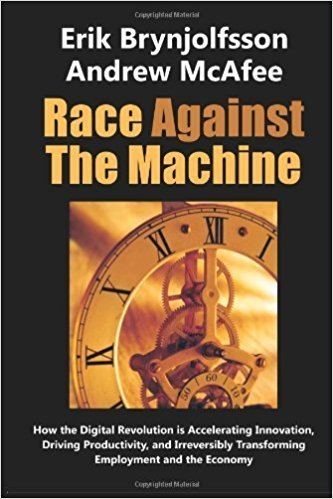7.8 /10 1 Votes7.8
Originally published 2011 | 3.9/5 Goodreads ISBN 0-984-72511-3 | |||||||||||||||||||||||||||||||||
 | ||||||||||||||||||||||||||||||||||
Similar Erik Brynjolfsson books, Other books | ||||||||||||||||||||||||||||||||||
Race against the machine andrew mcafee at tedxboston
Race Against the Machine is a non-fiction book from 2011 by Erik Brynjolfsson and Andrew McAfee about the interaction of digital technology, employment and organization. The full title of the book is: Race Against the Machine: How the Digital Revolution Is Accelerating Innovation, Driving Productivity, and Irreversibly Transforming Employment and the Economy.
Contents
The main thesis of this book is that we are in the midst of a technological revolution that is radically redefining what work is, how value is created, and how the economy distributes that value. The authors stumbled upon these ideas after analyzing the unique economic recovery that followed the Great Recession of 2008. When the recession ended, many measures of economic health (such as GDP, corporate profits, and investment in equipment and software) rebounded quickly; however, one measure, unemployment, lagged behind. This observation led the authors to conclude that a drastic shift in the means of production was taking place. The authors believe that technology is causing this shift, simultaneously boosting the productivity of firms while also eliminating the need for many forms of human labor. As the authors came to this conclusion, they looked around to see if anyone else had begun to analyze this trend. When they found that technology was largely being left out of the mainstream discussion of unemployment, they decided that they would write this book to help get the ball rolling. One supporting point in the book is that the pace of automation has picked up in recent years due to a combination of increasingly clever technologies such as robotics, numerically controlled machines, computerized inventory management software, speech recognition, speaker recognition, language translation, self-driving vehicles, pattern recognition and online commerce. The authors write that businesses are increasingly substituting machines for people, and that rate at which digital technologies are advancing is exponentially higher than that of the organizations, institutions, and individuals within our economy. Additionally, the corporate use of equipment and software is increasing faster than the rate than employment.
Brynjolfsson and McAfee write that advanced digital technologies are making people more innovative, productive and richer, both in the short- and long-term, but potentially at the cost of increasing wealth inequality in society. In the authors' view, one of the main in-egalitarian consequences of digital technological developments is its potentially negative impact on some types of employment, such as routine information processing work. The authors appear to advocate for a collaborative partnership between computers and humans as the road to future job creation. "In medicine, law, finance, retailing, manufacturing and even scientific discovery," they write, "the key to winning the race is not to compete against machines but to compete with machines."
Recommendations
Given the advancement of technology, the authors have several recommendations for policymakers in the United States to increase economic prosperity, including:
